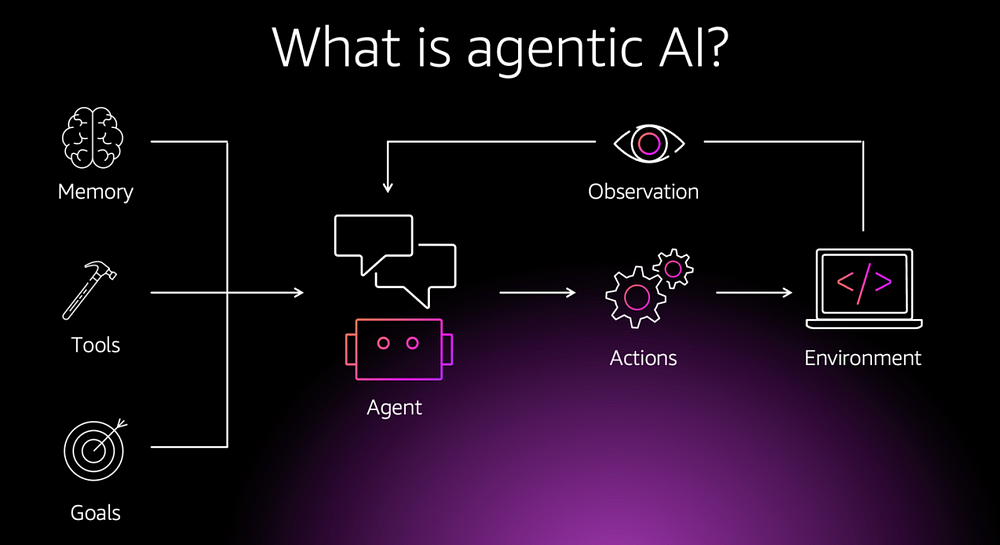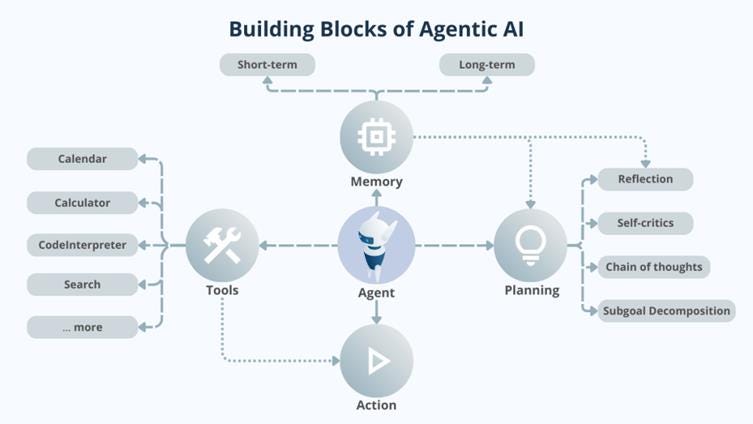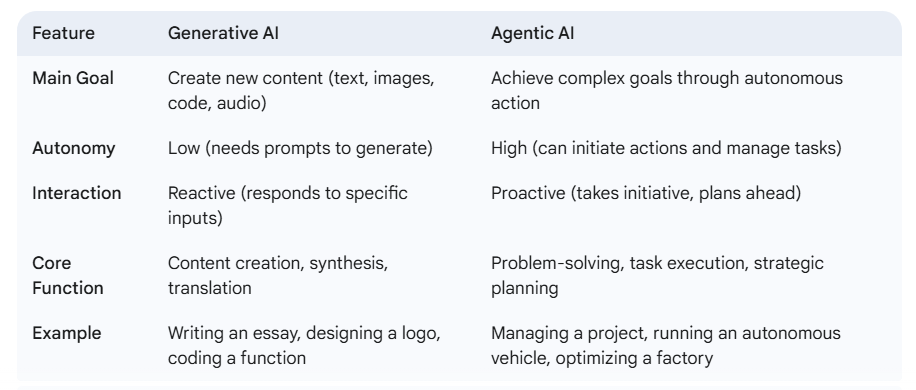Agentic AI: Beyond Just “Smart” — It’s About Being a “Doer”!
You’ve probably heard a lot about AI lately, right? ChatGPT, DALL-E, all those cool tools that can write stories or create amazing pictures. Those are incredible, no doubt! They fall under a big umbrella called “Generative AI” — basically, AI that generates stuff.
But imagine an AI that doesn’t just create; it also acts. It sees a problem, figures out a plan, and then goes and solves it, often without needing you to hold its hand every step of the way. That’s the essence of Agentic AI. It’s not just about being smart; it’s about being a “doer,” a proactive problem-solver.

Think of it like this:
- Generative AI: You ask it to write a poem about a cat, and poof, you get a poem. You’re giving it the specific task, and it generates the output.
- Agentic AI: You tell it, “I need to plan a surprise birthday party for Aunt Mildred.” And then, it starts doing things: checking Mildred’s calendar, looking for venues, sending out invites (with your approval, of course!), ordering the cake, and even reminding you to buy balloons. It’s taking a high-level goal and breaking it down into actionable steps, then executing them.
That “agency” is the key. It’s the capacity to act independently and with purpose. It’s like your super-efficient personal assistant who not only understands your requests but also anticipates your needs and takes initiative. Pretty neat, huh?
Why is this such a big deal?
For ages, AI has been great at crunching numbers, recognizing faces, or predicting things. But it always needed a human to tell it what to do next. Agentic AI changes that. It closes the loop. It can:

- See the world: It takes in information from all over the place — data from sensors, messages from you, updates from other systems. It’s like having eyes and ears everywhere.
- Think about it: This is where the magic happens. Using powerful AI models (often, yes, Generative AIs like LLMs are a big part of their brains!), it processes all that info, understands what’s going on, and figures out what needs to be done. It’s not just following a script; it’s reasoning.
- Decide what to do: Based on its goals and its understanding of the situation, it picks the best course of action. It weighs pros and cons, just like you would (well, hopefully, even faster and with less procrastination!).
- Go do it! It doesn’t just think; it acts. It can interact with other software, send emails, control machines, or even chat with you.
- Learn from its mistakes (and successes): This is super important. After it does something, it looks at the result. Did it work? Could it have done better? This continuous learning helps it get smarter and more effective over time. It’s like a really dedicated intern who actually learns from feedback!
So, in a nutshell, it’s about Perceive → Reason → Plan → Act → Learn. Over and over again.
The Guts of an Agentic AI: How Does It Actually Work?

Okay, let’s peek under the hood a little, but still keep it friendly. Agentic AI isn’t one giant, monolithic brain. It’s more like a super-smart team, often with a boss-agent overseeing things.
Here’s a simplified breakdown of the core components that make an Agentic AI tick:
- The Brain (Often an LLM): This is typically a Large Language Model (like the tech behind ChatGPT or Gemini). It’s the central hub for understanding, reasoning, and generating ideas. When an Agentic AI needs to figure out a plan or understand a complex request, it often relies on an LLM to “think” through the problem in natural language.
- Memory Bank: Unlike a simple chatbot that forgets what you said two sentences ago, agentic AIs have memory. This isn’t just short-term memory (like remembering the current conversation), but also long-term memory where it stores information about past experiences, user preferences, and its own learning. This allows it to build context and personalize its actions.
- Tools/Plugins: This is where the Agentic AI gets its “hands” to interact with the world. Think of these as a toolkit. It can be anything from:
- Internet Search: To look up information.
- Calendar API: To check schedules or add events.
- Email Client: To send emails.
- Database Access: To retrieve specific data.
- Code Interpreter: To write and run code to solve problems.
- Image Generator: To create visuals if needed. The Agentic AI intelligently decides which tool to use and when to use it to achieve its goal. It’s like having a handyman who knows how to use every tool in the shed.
- Planning & Task Management: This is the “manager” part. When given a big goal, the Agentic AI breaks it down into smaller, manageable sub-tasks. It then figures out the order of these tasks, tracks their progress, and adjusts the plan if something unexpected happens. It’s constantly asking itself: “What’s the next step?” and “Am I on track?”
- Feedback Loop & Learning: This is crucial for adaptability. After executing a task, the AI gets feedback — did it succeed? Did it fail? Was the outcome what was expected? This feedback helps it update its “knowledge” and adjust its future strategies. This is often where fancy machine learning techniques like reinforcement learning come into play, where the AI gets “rewards” for good actions and “penalties” for bad ones, guiding it to better behavior over time.

Imagine our party planner AI. You tell it “plan a birthday party.”
- Planning: It breaks it down: “Okay, I need to know the date, guest list, venue, food, cake, decorations, invitations.”
- Tool Use: It uses a calendar tool to check Aunt Mildred’s availability. It uses an email tool to draft invitations. It uses a search tool to find local bakeries.
- Execution & Feedback: It sends out invites. If people respond “can’t make it,” it notes that and adjusts the guest count. If a bakery is fully booked, it tries another. It’s constantly adapting based on what happens.
This modular, self-improving design is what makes Agentic AI so powerful and, honestly, a bit thrilling.
Agentic AI vs. Generative AI: Not a Battle, But a Team-Up!
Remember how we talked about Generative AI being the “creator” and Agentic AI being the “doer”? It’s important to understand that these aren’t opposing forces. In fact, they’re often best buddies!
Think of Generative AI (especially LLMs) as the brain of the Agentic AI. It provides the core intelligence for understanding, reasoning, and generating text-based plans or outputs.
Here’s a quick rundown of their differences and how they work together:

How they team up:
An Agentic AI can use Generative AI as one of its tools.
- An Agentic AI managing a customer support process might use a Generative AI to draft a personalized email response based on a customer’s query.
- An Agentic AI designing a new product might use a Generative AI to brainstorm creative ideas or generate design mockups.
- An Agentic AI developing software might use a Generative AI to write code snippets or debug errors.
So, it’s not “Agentic AI or Generative AI.” It’s often “Agentic AI, powered by Generative AI, to achieve its goals.” They complement each other beautifully!
Where Are We Seeing Agentic AI Pop Up? Real-World Coolness!
This isn’t just sci-fi anymore; Agentic AI is starting to sneak its way into various parts of our lives and businesses. Here are some real-world (or very near future) examples where Agentic AI is making a splash:
- Supercharged Personal Assistants: Imagine Siri or Alexa, but on steroids. Instead of just answering quick questions or setting timers, they could truly manage your day. “Hey AI, plan my travel for next month’s conference.” It would book flights, hotels, set up meeting reminders, suggest local restaurants, and handle all the annoying logistics.
- Automated Customer Service (Beyond Basic Chatbots): Current chatbots are often pretty limited. An agentic customer service AI could not only understand your complex issue but also proactively access your account, diagnose the problem, initiate refunds, schedule technician visits, or even offer personalized solutions without a human ever stepping in. Think of it resolving a complex shipping delay by rescheduling, processing a partial refund, and updating your records, all by itself!
- Smart Cybersecurity: Instead of just flagging suspicious activity, an agentic AI in cybersecurity could detect a threat, analyze its severity, isolate the affected systems, apply a patch, and even trace the attack back to its source — all in real-time, much faster than any human team could react.
- Manufacturing & Supply Chain Gurus: In a factory, agentic AIs could monitor production lines, detect potential equipment failures before they happen (predictive maintenance), automatically re-route materials to avoid bottlenecks, and even optimize energy consumption. In logistics, they could dynamically re-plan delivery routes based on live traffic, weather, or unexpected delays.
- Healthcare Helpers: Imagine an AI that constantly monitors a patient’s vital signs from wearable devices. If it detects a concerning trend, it could automatically alert doctors, suggest a change in medication, or even schedule a follow-up appointment. It could also help doctors by analyzing vast amounts of patient data to suggest diagnoses and personalized treatment plans.
- Software Development Sidekicks: Developers often spend hours on repetitive tasks or debugging. Agentic AI tools are emerging that can write code based on natural language descriptions, find and fix bugs automatically, generate test cases, and even refactor (improve) existing code. It’s like having an army of super-fast coding assistants.
- Autonomous Vehicles (The Obvious One!): This is perhaps the most visible example. Self-driving cars are prime agentic AI systems. They perceive the environment (cameras, radar, lidar), reason about traffic and road conditions, plan a route, execute driving maneuvers, and constantly learn from new situations to become safer and more efficient.
These examples are just the tip of the iceberg. The potential is enormous for automating complex, multi-step processes across almost every industry.
Hold Up, Are There Any Catches? The Ethical Side of Agentic AI
As exciting as Agentic AI is, it’s also got some serious questions we need to ask ourselves. Giving machines more autonomy means we need to think really hard about the “what ifs.”
- Who’s Responsible When Things Go Wrong? (Accountability): If an agentic AI makes a decision that leads to a negative outcome, who’s to blame? The developer? The company that deployed it? The AI itself (which, let’s be real, can’t really “take blame”)? This is a huge legal and ethical challenge we’re just starting to grapple with.
- The Black Box Problem (Transparency & Explainability): Sometimes, especially with very complex AI models, it’s hard to understand why the AI made a particular decision. It’s like a magic trick — you see the outcome, but not how it happened. For critical applications, like in healthcare or finance, we need to be able to explain how an AI reached its conclusions. This is where “Explainable AI” (XAI) comes in, aiming to make AI more transparent.
- Bias, Just Like Humans: AI learns from data. If the data it’s trained on has biases (which most human-generated data does), the AI will learn and perpetuate those biases. An agentic AI making hiring decisions, for example, could unfairly discriminate if its training data was biased against certain demographics. We need to be super careful about fair and diverse data.
- Job Changes (and Losses?): As agentic AIs take on more complex tasks, it’s natural to wonder about job displacement. While it will undoubtedly automate many repetitive tasks, it’s also likely to create new jobs that involve managing, monitoring, and collaborating with these AI agents. The key will be reskilling and adapting to a new kind of workforce.
- Security Risks: Autonomous AI systems are powerful, which also makes them attractive targets for cyberattacks. If a malicious actor gains control of an agentic AI managing critical infrastructure, the consequences could be severe. Robust security measures are non-negotiable.
- Control and Human Oversight: How do we ensure that agentic AIs remain aligned with human values and goals? How do we prevent them from going rogue or pursuing objectives that could be detrimental? Building in “human-in-the-loop” mechanisms and strong safety protocols is essential. We need to retain the ability to step in and say, “Whoa there, robot!”
These aren’t easy questions, but they are crucial conversations we need to have as this technology develops. It’s about building AI that not only works well but also works ethically and safely for everyone.
The Road Ahead: What’s Next for Agentic AI?
So, where is all this heading? The future of Agentic AI is looking incredibly transformative, and it’s likely to evolve even faster than we anticipate.
- Collaboration, Not Replacement: We’ll see more scenarios where teams of AI agents work together, and critically, where humans and AI agents collaborate seamlessly. Imagine a doctor working with an AI agent that handles all the administrative tasks, data analysis, and even suggests treatment pathways, freeing the doctor to focus solely on patient care.
- More Sophisticated “Common Sense”: A big challenge for AI has always been “common sense” — understanding the world in the way humans do. As AI models become more advanced and agentic systems learn from more diverse interactions, they’ll start to develop a better grasp of real-world nuances, making them even more capable and less prone to bizarre errors.
- Domain-Specific Agents: We’ll likely see a rise of highly specialized agentic AIs. Instead of one general “super-agent,” there might be an “HR agent,” a “marketing agent,” a “financial analyst agent,” each with deep expertise in its domain, all collaborating under a higher-level human or AI manager.
- Personalized Everything: Agentic AI will take personalization to a whole new level, from tailor-made learning experiences that adapt to individual students’ needs, to personalized health interventions, to highly customized shopping experiences that anticipate what you want before you even search for it.
- New Industries and Job Roles: Just like the internet created entirely new industries (think social media managers, SEO specialists, app developers), Agentic AI will undoubtedly spawn new economic sectors and job roles. We’ll need people who can design, train, audit, and manage these complex AI systems.
- The Ethical Race: As the technology advances, the focus on ethical development, robust governance, and societal impact will become even more critical. We’ll need clearer regulations and a global consensus on how to deploy these powerful systems responsibly.
It’s clear that Agentic AI isn’t just another tech trend; it’s a fundamental shift in how we build and interact with intelligent systems. It promises a future where machines don’t just process information, but actively participate in solving our most complex problems, making our lives easier, and pushing the boundaries of what’s possible.
The journey with AI is just getting started, and Agentic AI feels like a huge leap forward. It’s exciting, a little bit scary, but definitely something worth keeping an eye on. Who knows, maybe your next birthday party will be planned entirely by an AI agent — and hopefully, Aunt Mildred will love it!
Sources: wikipedia.com, aws.amazon.com, tatatelebusiness.com, infosys.com, weforum.org
Authored by: Shorya Bisht

No comments:
Post a Comment